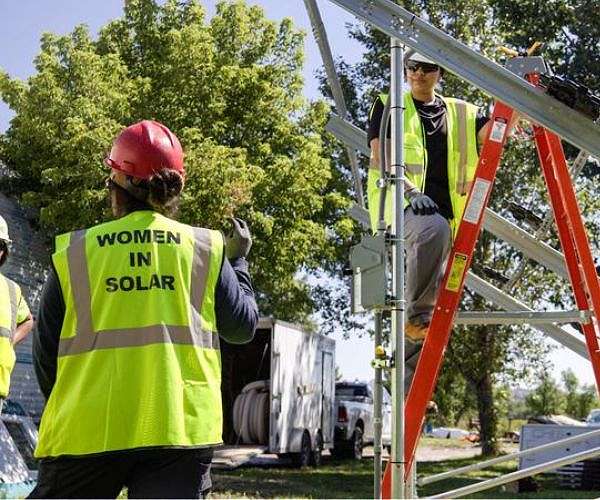New initiative gives Indian women the opportunity to follow solar training
Native American women across the country will have access to hands-on training in photovoltaic panel installation, with the goal of empowering them to deploy solar systems in their communities and homes on tribal lands.
Sandra Begay, an engineer at Sandia National Laboratories and a member of Navajo Nation, is one of four mentors guiding this effort.
This training initiative is part of a cooperative research and development agreement between Sandia and Red Cloud Renewable, a nonprofit organization in Pine Ridge, South Dakota, focused on advancing energy independence for tribal members and communities.
Known as the Bridging Renewable Industry Divides in Gender Equality or BRIDGE program, the initiative offers a five-week immersive training experience that emphasizes practical photovoltaic installation skills.
In August, Begay joined the first group of participants in South Dakota.
“Five weeks is a long time to be away from home,” Begay said. “I encouraged and reminded the women that they made the right choice to participate in this program. We also used the time to reflect on what they learned.”
Participants learn the components of photovoltaic systems and how to install them safely and effectively.
Begay also provided insights into the energy challenges faced by tribal communities.
“There are over 20,000 homes on the Navajo Nation and some rural homes on the Hopi Reservation that do not have electricity. These are off-grid homes,” Begay said, noting that many of these homes rely on diesel generators. “We are looking at a clean energy future. We want to move away from these types of fuels and look at clean energy sources like solar energy.”
She highlighted that large-scale solar energy projects are being developed by the Navajo Nation and the Mountain Ute Tribe in Colorado.
“This program will provide participants with new job opportunities and a better understanding of where we are going with clean energy,” Begay said.
Red Cloud Renewable also supports the women with resume preparation, job application training, networking and job placement services.
With more than 30 years of experience advocating renewable energy in Native American communities, Begay is committed to fostering relationships with participants.
“I am making a long-term commitment to the women in the BRIDGE program,” Begay said. “I will share with them any vacancies I see and support them in their job search.”
Teamwork for success
Begay emphasized the crucial role that teamwork plays in photovoltaic installations.
“Photovoltaic installation is done with a team of people. How do you work through that group dynamic? How do you work together as a team? These questions are not emphasized enough in the work we do. They will rely on each other as they install photovoltaic systems,” she said.
Alicia Hayden, communications manager for Red Cloud Renewable, noted the strong bond that developed between participants.
“What struck me was the incredible camaraderie among the women,” Hayden said. “They were truly supportive of each other and grateful to be able to participate in this program alongside women from similar backgrounds.”
The project, funded by the Department of Energy’s Solar Energy Technology Office, will continue over the coming years and aims to train two additional groups, ultimately involving approximately 45 women.
“These women will be equipped to take on installer jobs within their own reserves, providing their people with valuable skills and opportunities for sustainable development,” Hayden said.
Despite being vastly underrepresented in the solar sector – which, according to Red Cloud Renewable, makes up just 0.05% of the sector – Native American women can benefit from this initiative.
Begay expressed optimism about the impact of the BRIDGE program.
“It is very rewarding both professionally and personally to see where we can help women who are underrepresented in the workforce, let alone with a unique technology like photovoltaics,” Begay said. “We’re sowing ideas for the women that they would never have thought of. I think that’s unique.”


